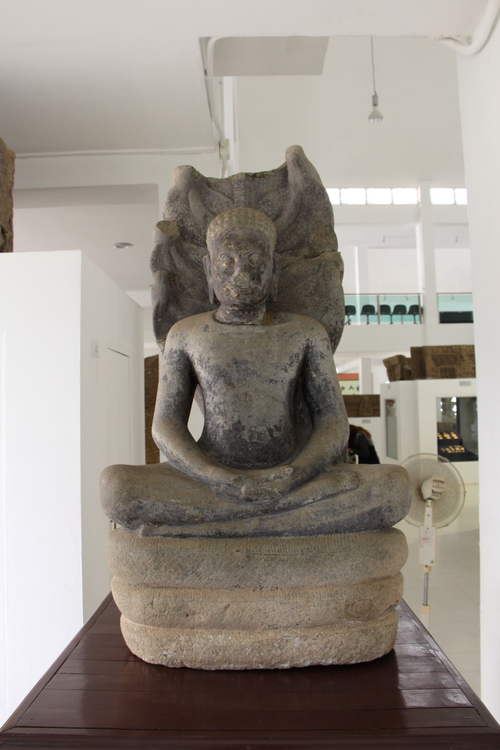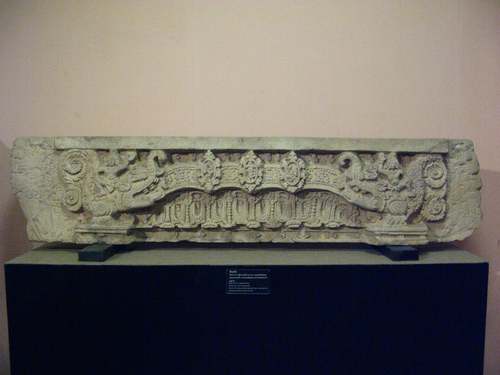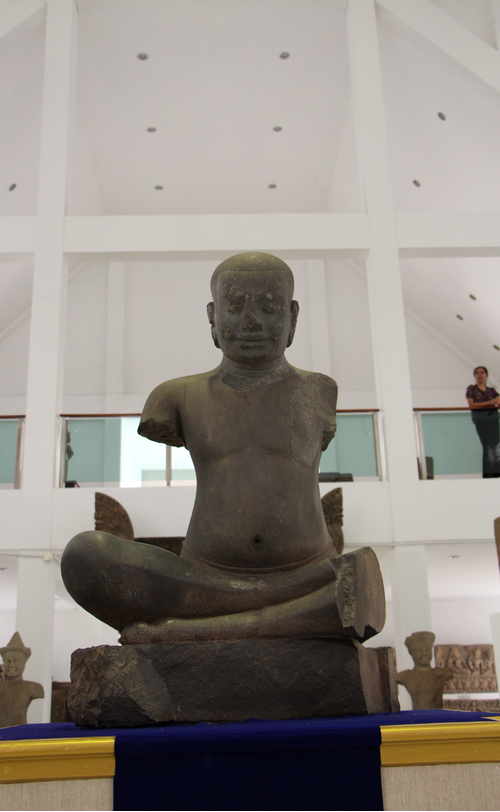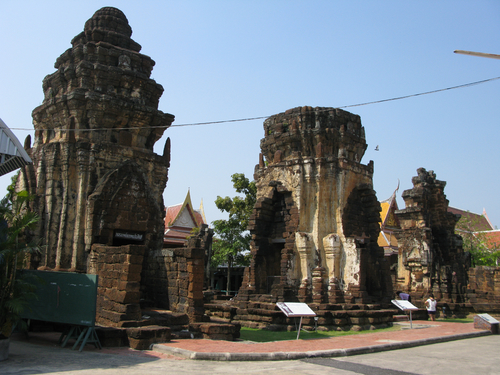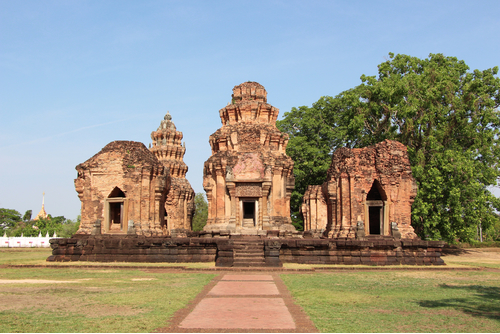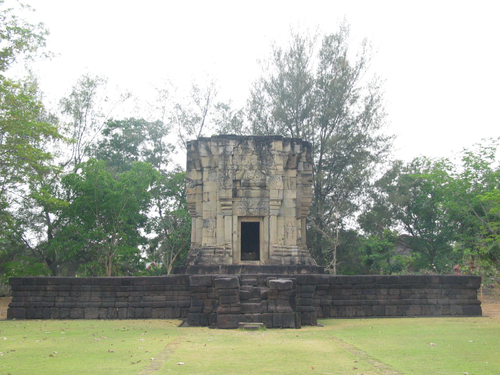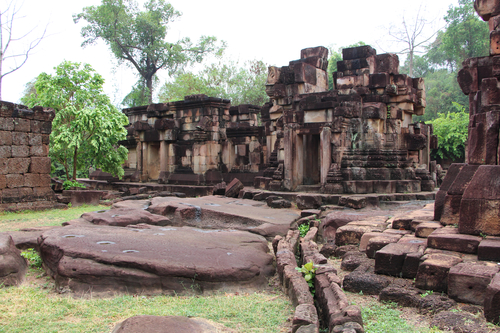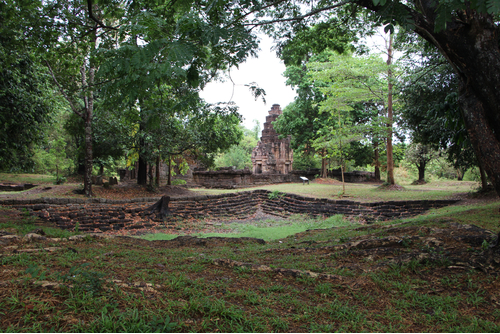ค้นหางานศิลปกรรม
ฐานข้อมูลศิลปกรรมในเอเชียตะวันออกเฉียงใต้
ประติมากรรมพระพุทธรูปนาคปรก
พระพุทธรูปอยู่ในอิริยาบถนั่งทำปางสมาธิ ขัดสมาธิราบ พระชงฆ์คมเป็นสันดังมนุษย์จริง ครองจีวรห่มเฉียง บางแนบพระวรกาย ไม่มีริ้ว พระพักตร์สงบ พระเนตรปิด แย้มพระโอษฐ์เล็กน้อย ขมวดพระเกศาเวียนเป็นวงก้นหอย พระอุษณีษะนูนเพียงเล็กน้อย ขนดนาคที่รองรับพระพุทธเจ้ามี 3 ขนด มีพังพานนาคหลายเศียรปกอยู่ทางด้านหลัง
ประติมากรรมทับหลังจากปราสาทเขาน้อยหลังเหนือ
ทับหลังทรงสี่เหลี่ยมผืนผ้า ตรงกลางสลักลายวงโค้ง 4 วงต่อเนื่องกัน จุดบรรจบของแต่ละวงโค้งตกแต่งด้วยลายวงรูปไข่ที่ประดับภายในด้วยภาพเทพเจ้าทรงพาหนะ ใต้วงโค้งสลักลายพวงมาลัยและอุบะ ถัดจากปลายวงโค้งทั้งสองข้างเป็นรูปมกรหันหน้าเข้าสู่ด้านใน อ้าปากราวกับว่ากำลังคายท่อนวงโค้ง มีรูปบุคคลนั่งเหนือมกร และมีแท่นฐานสี่เหลี่ยมรองรับมกร
ประติมากรรมพระเจ้าชัยวรมันที่ 7
ประติมากรรมฉลองพระองค์พระเจ้าชัยวรมันที่ 7 มีสภาพชำรุดบางส่วน พระกรทั้งสองข้างและพระชานุซ้ายหักหายไป พระพักตร์เหลี่ยม พระเนตรปิด แย้มพระโอษฐ์เล็กน้อย พระเกศายาวเกล้าเป็นมวย พระวรกายท้วม ช่วงบนไม่ทรงอาภรณ์ใดๆ ช่วงล่างทรงสมพตสั้น นั่งอยู่ในอิริยาบถขัดสมาธิ พระหัตถ์ที่หักหายไม่ทราบว่าทำท่าทางใด แต่บางท่านสันนิษฐานว่าประนมกรไว้ เพราะหากทำท่าสมาธิหรือวางบนพระเพลาจำต้องเห็นร่องรอยของฝ่าพระหัตถ์ที่ติดอยู่กับพระเพลา
สถาปัตยกรรมปราสาทกำแพงแลง
ปราสาทกำแพงแลงมีผังพื้นล้อมรอบด้วยกำแพงศิลาแลงเป็นรูปสี่เหลี่ยมจัตุรัส หันหน้าไปทางทิศตะวันออก ภายในกำแพงศิลาแลงเป็นที่ตั้งของปราสาทศิลาแลงแบบศิลปะเขมรทั้งหมด 4 องค์ ปราสาท 3 องค์ทางด้านหน้าวางตัวเรียงกันในแนวเหนือ-ใต้ โดยปราสาทประธานมีขนาดสูงใหญ่กว่าอีก 2 องค์ คล้ายกับปรางค์สามยอด ลพบุรี ส่วนปราสาทองค์ที่ 4 ตั้งอยู่ด้านหลังของปราสาทประธานด้านทิศตะวันออก และยังปรากฏลวดลายปูนปั้นประดับปราสาท ด้านหน้ามีโคปุระหรือซุ้มประตูทางเข้า 1 หลัง ภายในกำแพงศิลาแลงยังพบสระน้ำอยู่ชิดขอบกำแพงทางทิศตะวันออกด้วยนอกจากนี้ยังพบโบราณวัตถุสำคัญ ได้แก่ พระโพธิสัตว์โลเกศวรเปล่งรัศมี, ส่วนพระวรกายของพระโพธิสัตว์โลเกศวรสี่กร, ส่วนพระวรกายของพระพุทธรูปนาคปรกทรงเครื่อง, เศียรนางปรัชญาปารมิตา จากการใช้ศิลาแลงเป็นวัสดุหลักในการสร้างปราสาท และลักษณะของการวางผังปราสาททิศเหนือ ปราสาทองค์กลาง และปราสาททิศใต้ เป็นไปในลักษณะการวางตามคติการนับถือรัตนตรัยมหายาน ปราสาททิศเหนือได้แก่พระนางปรัชญาปารมิตา ปราสาทองค์กลาง คือพระวัชรสัตว์นาคปรก และจากปราสาททิศใต้ได้แก่ พระโพธิสัตว์อวโลกิเตศวร ซึ่งคติการนับถือรูปเคารพทั้งสามรูปเรียงกันในแนวนี้ เป็นคติการนับถือรูปเคารพในพุทธศาสนามหายาน สมัยพระเจ้าชัยวรมันที่ 7 พุทธศตวรรษที่ 18 จึงสามารถกำหนดอายุเวลาในการสร้างปราสาทกำแพงแลงนี้ได้ว่าร่วมสมัยกับพระเจ้าชัยวรมันที่ 7 และจารึกที่ปราสาทพระขรรค์ ประเทศกัมพูชา กล่าวถึงเมือง “ศรีชัยวัชรปุระ” (เมืองเพชรบุรี) หนึ่งในหกเมืองโบราณในภาคกลางที่มีการกล่าวต่อไปอีกว่าได้มีการส่งพระชัยพุทธมหานาถ 1 ใน 23 องค์จากเมืองพระนครหลวง มาประดิษฐานที่เมืองเพชรบุรีนั่นก็คือปราสาทวัดกำแพงแลง และเมื่อเทียบกับโบราณสถานแล้ว ก็เป็นสิ่งที่ยืนยันได้ว่า ปราสาทกำแพงแลงแห่งนี้ ก็คือปราสาทที่กล่าวถึงในจารึกนั้น ซึ่งปราสาทพระขรรค์เป็นปราสาทที่ร่วมสมัยกับพระเจ้าชัยวรมันที่ 7 เช่นกัน
สถาปัตยกรรมปราสาทศีขรภูมิ
ประกอบด้วยปราสาทอิฐจำนวน 5 หลังตั้งอยู่บนฐานเดียวกัน ปราสาทประธานมีขนาดใหญ่ที่สุดในขณะที่อีก 4 หลังตั้งอยู่ที่มุม ทั้ง 4 ปราสาทล้อมรอบด้วยคูน้ำยกเว้นทางด้านทิศตะวันออกซึ่งเป็นทางเข้าปราสาทแห่งนี้สร้างขึ้นในพุทธศตวรษที่ 17 ซึ่งตรงกับศิลปะร่วมแบบนครวัด โดยสามารถกำหนดอายุได้จากลวดลายบนกรอบประตูและทับหลังของปราสาทประธาน อย่างไรก็ดี ปราสาทแห่งนี้ยังคงสร้างด้วยอิฐ อันแตกต่างไปจากปราสาทสมัยนครวัดในประเทศกัมพูชาที่นิยมสร้างด้วยหินทรายเสมอแผนผังของปราสาทศรีขรภูมิ มีความพิเศษที่แตกต่างไปจากปราสาทหลังอื่นๆในประเทศไทย เนื่องจากเป็นปราสาท 5 หลังที่ตั้งอยู่บนฐานไพทีเดียวกัน โดยปราสาทประธานตั้งอยู่ตรงกลางและล้อมรอบไปด้วปราสาทบริวารอีก 4 มุม ลักษระเช่นนี้แตตก่งไปจากปราสาทที่พบในประทศไทยโดยทั่วไปที่มักเป็นปราสาท 3 หลังเรียงกันอยู่บนฐานไพทีปราสาทประธานของปราสาทศีขรภูมิ รวมถึงปราสาทหลังอื่นๆ มีลักษณะเป็นปราสาทเดี่ยวที่ไม่มีการต่อเชื่อมมณฑป ส่วนที่เป็นผนังเรียบๆ มักใช้อิฐเป็นวัสดุหลัก ส่วนที่ต้องสลัก เช่น ทับหลัง เสาประดับกรอบประตูและเสากรอบประตู มักใช้หินทรายในการสลัก การปะปนกันของวัสดุสองประเภทนี้ ปรากฏมาก่อนแล้วตั้งแต่ปราสาทสระกำแพงใหญ่ซึ่งตั้งอยู่ในบริเวณใกล้เคียงกัน และถือเป็นลักษณะพื้นเมืองของปราสาทขอมในดินแดนไทยเอง เนื่องจากปราสาทสมัยนครวัดในประเทศกัมพูชาย่อมสลักด้วยหินทรายเสมอ เนื่องจากปราสาทประธานปรากฏทับหลังรูปศิวนาฏราช จึงเป็นไปได้สูงที่ปราสาทหลังนี้สร้างขึ้นในลัทธิไศวนิกาย ปราสาททั้งห้าหลังนี้จึงอาจเคยประดิษฐานศิวลึงค์อันเป็นสัญลักษณ์ของพระศิวะก็ได้ ในระยะหลัง ปราสาทแห่งนี้ถูกเปลี่ยนแปลงเป็นศาสนสถานในพุทธศาสนาเถรวาทโดยชาวลาวที่อพยพเข้ามาภายหลัง หลักฐานที่สำคัญได้แก่จารึกกรอบประตูและการซ่อมแปลงยอดของปราสาทบริวารหลังตะวันตกเฉียงใต้มีลักษณะคล้ายพระธาตุศิลปะล้านช้างในพุทธศาสนา มีการก่อยอดขึ้นไปใหม่เลียนแบบยอดปราสาทในศิลปะขอมแต่มีรูปแบบแตกต่างไปจากต้นแบบอย่างชัดเจน ส่วนกลีบขนุนก็มีการนำขึ้นไปจัดเรียงใหม่ด้วย
สถาปัตยกรรมปราสาทบ้านพลวง
เป็นปราสาทขนาดเล็กหลังเดียวสร้างจากหินทราย ตั้งอยู่บนฐานไพทีรูปกากบาทขนาดใหญ่ที่สร้างจากศิลาแลง การที่ฐานศิลาแลงนี้มีปีก 2 ข้างซึ่งมีขนาดใหญ่กว่าตัวปราสาทมากจึงทำให้คิดไปได้ว่าอาจเคยมีแผนในการสร้างปราสาทบริวารด้วย แต่ปัจจบันไม่ปรากฏแล้ว โดยที่ไม่ทราบว่าเนื่องจากปราสาทดังกล่าวไม่เคยสร้างเสร็จ หรือเคยเป็นไม้จึงได้สูญหายไปหมดแล้วปราสาทหลังนี้เป็นตัวอย่างปราสาทขนาดเล็กที่มีภาพสลักที่ค่อนข้างสมบูรณ์ ประตูหลักอยู่ทางทิศตะวันออกในขณะที่อีกสามด้านเป็นประตูหลอก ตัวปราสาทมีภาพสลักในศิลปะร่วมแบบบาปวนอย่างงดงามทั้งบนทับหลังและหน้าบันอันทำให้พอกำหนดอายุได้ว่าอาจมีอายุในราวพุทธศตวรรษที่ 16 ถึงต้นพุทธศตวรรษที่ 17 สำหรับยอดของปราสาทนั้นอาจเป็นไปได้ที่เคยก่อด้วยอิฐมาก่อน เมื่อเวลาผ่านไปจึงสูญหายไปตามกาลเวลาทับหลังของปราสาทหลังนี้มักประกอบด้วยหน้ากาลแลบลิ้นสามเหลี่ยมคายท่อนพวงมาลัยตามแบบบาปวนโดยทั่วไป บางครั้งทับหลังก็มีพวงอุบะมาแบ่งตรงเสี้ยว บางครั้งก็ไม่มีซึ่งลักษณะเช่นนี้เป็นการพิสูจน์ว่าทับหลังแบบมีเสี้ยวและไม่มีเสี้ยวนั้นได้รับความนิยมในระยะร่วมสมัยกันส่วนหน้าบันนั้นมีลักษณะเป็นแบบบาปวนโดยทั่วไปเช่นกัน กล่าวคือ มีกรอบหน้าบันเป็นรูปก้านต่อดอกหันหัวลง มีนาคที่มีกระบังหน้า ภายในหน้าบันประกอบด้วยลายพรรณพฤกษาที่มีหน้ากาลคายอยู่เบื้องล่าง อนึ่ง เนื่องจากนาคปลายกรอบหน้าบันเริ่มมีกระบังหน้าแล้ว จึงอาจเป็นไปได้ที่ปราสาทหลังนี้คงมีอายุอยู่ในสมัยบาปวนตอนปลาย และอาจมีอายุหลังจากปราสาทเขาพระวิหารและปราสาทเมืองต่ำเล็กน้อย ทั้งหน้าบันและทับหลังของปราสาทหลังนี้ แสดงภาพพระกฤษณะในตอนต่างๆ เช่น กฤษณะยกภูเขาโควรรธนะ และกฤษณะปราบนาคกาลียะ นอกจากนี้ยังปรากฏภาพพระอินทร์ทรงช้างเอราวัณในหลายจุดอีกด้วย
สถาปัตยกรรมปราสาทตาเมือนธม
ปราสาทตาเมือนธม เป็นปราสาทขนาดใหญ่ก่อสร้างด้วยหินทรายและศิลาแลง 3 องค์ ประกอบด้วยปราสาทประธานขนาดใหญ่ แผนผังรูปสี่เหลี่ยมจัตุรัสย่อมุม ภายในห้องกลางปราสาทประดิษฐานศิวลึงค์ ซึ่งเป็นสัญลักษณ์แทนพระศิวะ เทพเจ้าสูงสุดในศาสนาพราหมณ์ ลัทธิไศวนิกาย ลักษณะของศิวลึงค์นี้ตกแต่งจากแท่งหินทรายธรรมชาติที่มีรูปร่างคล้ายศิวลึงค์ที่ตั้งอยู่บริเวณนี้มาแต่เดิม ภายหลังจึงสร้างปราสาทครอบ สันนิษฐานว่านี้น่าจะเป็นศิวลึงค์ที่เกิดขึ้นเอง เรียกว่า “สวายัมภูลึงค์” ซึ่งเป็นศิวลึงค์ที่สำคัญที่สุดของลัทธิไศวนิกาย ตัวปราสาทมีซุ้มประตู 4 ทิศ ประตูมุขด้านทิศใต้ต่อเข้ากับมุขหน้าหรือมณฑปยื่นออกมา โดยแบ่งเป็น 3 คูหา หลังคาทำด้วยหินทราย ปราสาทประธานมีการสลักลวดลายที่บริเวณฐาน โดยสลักเป็นรูปเทวรูปยืน นอกจากนี้ยังพบทับหลังหินทรายสลักภาพเทวดานั่งชันเข่าอยู่ภายในซุ้มบนแท่นเหนือหน้ากาลที่คายท่อนพวงมาลัยปราสาทบริวาร หรือ ปรางค์น้อยมี 2 องค์ สร้างด้วยหินทราย ตั้งอยู่ด้านหลังเยื้องไปทางซ้ายและขวาของปราสาทประธาน แผนผังเป็นรูปสี่เหลี่ยมจัตุรัสย่อมุม มีซุ้มประตูเข้าออกอยู่ด้านทิศใต้ ส่วนอีก 3 ด้านทำเป็นประตูหลอกบรรณาลัย จำนวน 2 หลัง สร้างด้วยศิลาแลง หลังหนึ่งตั้งอยู่ด้านทิศตะวันออกเฉียงใต้ของปราสาทประธาน แผนผังเป็นรูปสี่เหลี่ยมผืนผ้า ส่วนอีกหลังหนึ่งตั้งอยู่ด้านทิศตะวันตกเฉียงใต้ของปราสาทประธาน แผนผังเป็นรูปสี่เหลี่ยมจัตุรัสปราสาทประธาน ปรางค์บริวาร และบรรณาลัย มีระเบียงคดล้อมรอบ ซุ้มประตูหรือโคปุระสร้างด้วยหินทราย มีแผนผังเป็นรูปสี่เหลี่ยมจัตุรัส มีช่องทางเดินภายในกว้างประมาณ 1.40 เมตร มีซุ้มประตูทั้ง 4 ด้าน โดยซุ้มประตูด้านทิศเหนือ ตะวันออก และตะวันตก มีลักษณะเหมือนกัน ส่วนซุ้มประตูด้านทิศใต้จะมีขนาดใหญ่ที่สุด เป็นซุ้มประตูหลัก โดยแบ่งออกเป็น 3 คูหา คูหากลางมีแผนผังเป็นรูปกากบาท มีหน้าต่างติดลูกกรงหินและบริเวณระเบียงคดนี้ได้พบศิลาจารึกอักษรขอมโบราณ ภาษาสันสกฤตและเขมร ซึ่งเป็นตัวอักษรที่ใช้ในราวปลายพุทธศตวรรษที่ 16 มีเนื้อหากล่าวสรรเสริญพระศิวะและกล่าวถึงนามของทาสและเจ้าหน้าที่ผู้ดูแลรักษาเทวสถานแห่งนี้ นอกจากนี้ยังพบท่าน้ำสร้างด้วยหินทรายนอกระเบียงคดด้านทิศใต้ ห่างออกไปประมาณ 10 เมตร และสระน้ำกรุด้วยศิลาแลงสอบลงไปถึงก้นสระ อยู่บริเวณนอกระเบียงคดทิศตะวันตกเฉียงเหนือ
สถาปัตยกรรมปราสาทตาเมือนโต๊ด
ปราสาทตาเมือนโต๊ด เป็นศาสนสถานพยาบาลเรียกว่า “อโรคยศาล” เพื่อให้เป็นสถานที่รักษาพยาบาลผู้เจ็บป่วย สร้างขึ้นในสมัยพระเจ้าชัยวรมันที่ 7 อายุราวพุทธศตวรรษที่ 18 องค์ประกอบทางสถาปัตยกรรมของอโรคยศาล จะมีลักษณะเหมือนกันทุกแห่ง คือ ปราสาทประธาน 1 หลัง สร้างด้วยศิลาแลงและหินทราย แผนผังเป็นรูปสี่เหลี่ยมจัตุรัสย่อมุม ส่วนยอดสลักด้วยหินทราย ลายกลีบบัว มีประตูทางเข้าออกด้านเดียว ส่วนอีก 3 ด้านทำเป็นประตูหลอก ประตูทางเข้าออกนี้ทำเป็นห้องยาวๆ ด้านหน้าเป็นมุข หลังคาทำจากหินทรายและศิลาแลง และด้านทิศตะวันออกเฉียงใต้ของปราสาทประธาน มีบรรณาลัยสร้างด้วยหินทรายและศิลาแลง แผนผังเป็นรูปสี่เหลี่ยมผืนผ้า มีประตูทางเข้าออก 1 ประตู ด้านทิศตะวันออก ทั้งหมดอยู่ในเขตกำแพงแก้วและซุ้มประตูสร้างด้วยศิลาแลง กำแพงแก้วมีแผนผังเป็นรูปสี่เหลี่ยมผืนผ้า มีซุ้มประตูอยู่ทางด้านทิศตะวันออก ซึ่งแบ่งออกเป็น 3 คูหา และบริเวณคูหากลางพบศิลาจารึก 1 หลัก ปัจจุบันอยู่ที่อาคารหอพระสมุดวชิรญาณ กรุงเทพมหานคร เป็นจารึกอักษรขอม ภาษาสันสกฤต สร้างขึ้นเมื่อประมาณพุทธศตวรรษที่ 18 สมัยพระเจ้าชัยวรมันที่ 7 ข้อความกล่าวถึง“พระไภษัชยครุไวฑูรยะ” หมายถึงพระโพธิสัตว์ผู้ประทานความไม่มีโรคแก่ประชาชนผู้นับถือ และกล่าวถึงเรื่องการสร้างอโรคยศาล หรือโรงพยาบาลให้เป็นสถานที่รักษาโรค โดยพระเจ้าชัยวรมันที่ 7 ทรงบริจาควัสดุอุปกรณ์พร้อมทั้งจัดเจ้าหน้าที่ให้อยู่ประจำสถานพยาบาลด้วย ส่วนด้านทิศตะวันออกเฉียงเหนือของปราสาท นอกกำแพงแก้วมีสระน้ำ 1 สระ
